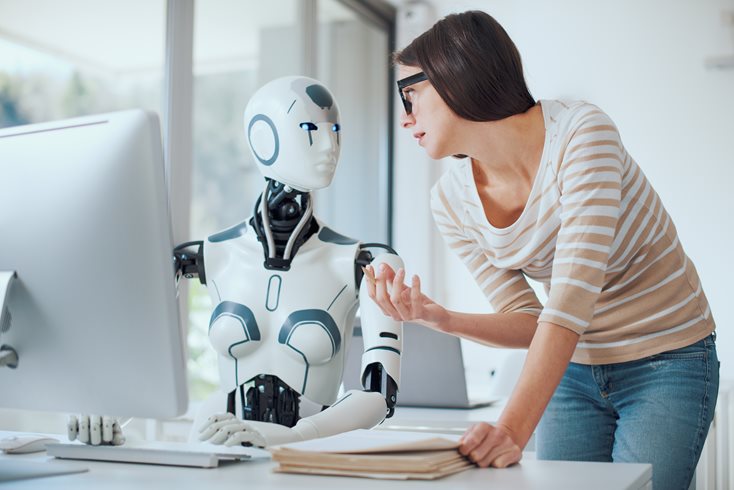Embracing AI: No, AI is NOT Coming for Your Job
The advent of artificial intelligence (AI) has stirred both intrigue and apprehension across various industries, particularly in the realms of technology, business and content creation. Amidst discussions surrounding potential job displacement, it's essential to view AI not as a threat but as a catalyst for innovation and productivity enhancement.

While AI's growth trajectory is undeniably swift, there's a compelling argument to be made that it won't displace workforces but instead create more job opportunities in sectors touched by artificial intelligence.
Rand Fishkin, the esteemed co-founder of industry behemoths MOZ and SparkToro, recently took to LinkedIn to present a few bold predictions:
He states that within the next five years, less than 10% of all information-economy jobs and less than 5% of marketing jobs will succumb to displacement by AI.
This assertion challenges the prevailing narrative of AI as a job usurper and highlights the potential for harmonious coexistence between AI and human professionals.
Fishkin's prognostication draws heavily from historical precedent.
He draws parallels to past technological advancements such as spreadsheets, word processors, and image editing software, which, despite initial concerns regarding job displacement, ultimately fostered the creation of more employment opportunities.
This historical alignment suggests that AI may follow a similar trajectory, augmenting human capabilities rather than rendering them obsolete.
However, Fishkin also acknowledges the long-term challenges confronting AI adoption.
He points to potential obstacles in the form of regulations on copyright and concerns over energy consumption, which could impede the unrestricted growth of AI.
These challenges underscore the necessity for a balanced approach to AI integration—one that acknowledges both its potential benefits and drawbacks.
A critical insight highlighted is the limited adoption of raw AI-generated content. Despite significant advancements in AI technology, AI-generated content has yet to surpass the quality produced by top creators.
Instead, AI serves as a tool to enhance efficiency, enabling professionals to automate repetitive tasks and concentrate on more creative endeavors.
This nuanced perspective challenges the notion of AI as a wholesale replacement for human creativity and underscores its role as a facilitator of productivity.
Moreover, current labor market trends offer further evidence that AI adoption hasn't led to widespread job displacement. Information economy jobs continue to proliferate, signaling resilience in the face of technological disruption.
This trend mirrors adoption patterns observed in previous technological advancements like Excel, Photoshop, and social media, which ultimately enhanced rather than replaced human labor.
Contrary to popular belief, AI is not a job usurper; it's a force multiplier that enables professionals to achieve more in less time.
From keyword research and content optimization to performance tracking and personalized user experiences, AI-driven tools are revolutionizing the way SEO and digital marketing are conducted.
Practical Strategies for Leveraging AI for Enhanced Productivity
1. Stay Informed and Adapt
Continuously educate yourself on the latest advancements in AI technology and how they intersect with SEO and digital marketing.
Follow thought leaders like Rand Fishkin, Neil Patel, and others who offer valuable insights and perspectives on leveraging AI effectively.
2. Explore AI-Powered Tools
Familiarize yourself with AI-driven platforms such as SEMrush, MarketMuse, and Clearscope, which offer features for keyword research, content optimization, and performance analysis.
Experiment with different tools to identify those that best suit your workflow and objectives.
3. Invest in Continuous Learning
Enroll in online courses, attend webinars, and participate in workshops focused on AI and its applications in SEO and digital marketing.
Platforms like Coursera, Udemy, and LinkedIn Learning offer a plethora of resources to help you upskill in this rapidly evolving field.
4. Collaborate with AI
Embrace collaboration between humans and AI, recognizing that each brings unique strengths to the table.
Use AI to analyze data, identify patterns, and generate insights, while leveraging human judgment to interpret results and devise strategies.
5. Integrate AI into Your Workflow
Utilize AI for tasks such as keyword research, content optimization, performance tracking, and personalized user experiences.
Automate repetitive tasks to free up time for strategic initiatives that require human creativity and critical thinking.
To Conclude...
Rand Fishkin's insights offer a balanced perspective on the relationship between AI and job displacement.
While AI's rapid growth may evoke concerns, historical precedent and current trends suggest that it isn't a threat to job security but rather a catalyst for innovation and productivity enhancement.
By embracing AI as a tool to augment human capabilities, professionals can navigate the evolving technological landscape with confidence and adaptability.